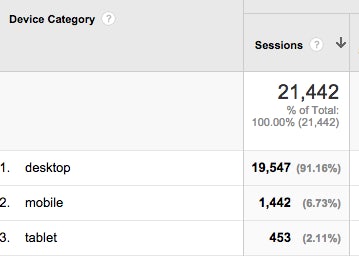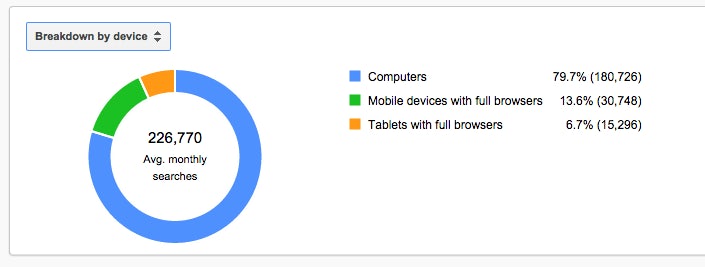Google’s mobile update will go live on April 21st 2015, giving mobile search ranking prominence to those websites which deliver a good experience to mobile users. Leaving many business owners and marketers asking what does it mean for me?
The short answer is that it really depends on your business – for now. If your website receives a significant proportion of its traffic from users on a mobile phone, you can expect to see your traffic decrease as of the 21st April. You can review the number of visits you get to your site on a mobile device using the ‘mobile’ report on Google Analytics.
But with the mobile update a part of Google’s ongoing mission to favour websites with a positive user experience, I suggest it won’t be too long before mobile-friendliness becomes a ranking factor on desktop and tablet devices too. This means that even if mobile traffic isn’t a big part of your traffic, an investment in a good mobile site is worthwhile.
You can check whether your website is considered mobile friendly or not using this mobile usability testing tool. In the meantime, here are the answers to the most common questions business owners and marketers are asking about the 21/4 update:
1. What is Google’s mobile update?
The update is intended to improve the quality of search results for users on a mobile phone, by using mobile-friendliness as a factor in deciding which sites should rank where in the mobile search results. You may have seen the ‘mobile-friendly’ label on some search results when you search on your phone, and this is something that we will continue to see once the update goes live, giving users a clear indication as to what they can expect when they click on that result.
Google announced the update through their Webmaster Central blog back in February. This isn’t the first clue we’ve had as to Google increasing focus on mobile though, the Google Mobile Playbook having been published back in 2012, giving webmasters advice to help them improve the mobile usability of their websites.
More recently, Google clarified that the update would be applied on a yes-or-no basis, meaning that your site is either mobile-friendly, or it’s not. Test your website’s mobile-friendliness using the mobile friendly test tool.
2. How do I know what effect it will have on my business?
The best place to look for a clue as to the impact of the update on your business is your Google Analytics account. Here, you can see a report on the proportion of traffic that comes to your website using a mobile device. It looks like this:
In this example, you can see that mobile visits account for just under 7% of all website visits. This website owner might decide that this isn’t a significant enough proportion for them to worry too much about the mobile update.
You should also review the quality of this traffic. Let’s say that the mobile traffic accounted for 7% of all visits but 40% of all conversions; this shows that the mobile traffic is highly valuable to the business and the April update should be cause for action.
You can also use Google’s keyword planner to identify the potential mobile search traffic for your key terms. Simply search for your keyword then choose the drop down box for ‘break down by device”:
Even if you find that mobile represents only a small proportion of your traffic and subsequent custom, I suggest it’s still worth considering a move to a mobile-friendly website as soon as possible, as mobile use continues to grow.
3. What does ‘mobile friendly’ mean?
‘Mobile-friendly’, put simply, means the website works well on a mobile. Try accessing your website via your mobile phone; how does it look? Is it easy to use? Can you click on things easily and can you see all the information you need?
According to Google’s own guidelines, a mobile-friendly website:
- Avoids software that is not common on mobile devices, like Flash
- Uses text that is readable without zooming
- Sizes content to the screen so that users have to neither scroll horizontally nor zoom
- Places links far enough apart so that the correct one can be easily tapped
You can test your website’s mobile-friendliness using Google mobile friendly test.
4. What should I do if my website isn’t mobile friendly?
If your website isn’t currently mobile friendly, you have two main options:
- Update your current site to be mobile friendly
- Invest in a new, responsive website
The first option, to update your current site, has the potential to be quite complex, but is worth exploring with your web developer as it could be the cheaper of the two choices. You should ask your developer about making your website responsive, which means it will render well on any size of screen.
The second option is to invest in a new, fully responsive website. This means your site will be designed and built in a way that suits all devices, no matter the screen size, as it will shrink and expand to fill the space. Try changing the size of your browser window as you read this now – our website is responsive, and as such you’ll see the content change to fit the space available.
Ideally, you’ll design your website using a mobile first approach, which means designing it for the mobile user first then expanding it for other users. This enables you to decide what content you need to display to mobile users and to structure your site in the best way for them.
Google’s mobile update is due to go live on April 21st. While this should certainly bring mobile-friendliness to the forefront of your mind, it’s by no means time to panic. Google recognises that not all websites are mobile friendly yet and that the investment in making a website which is can be much larger than many businesses can afford immediately. This means there’s likely to be some leeway over the coming months.
That said, now more than ever, your mobile strategy is essential to your business’ online success. Get in touch if you’d like to discuss your mobile strategy with our SEO or development teams.





